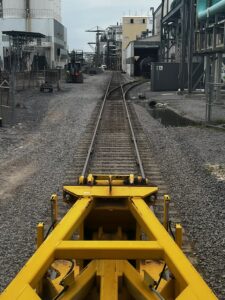Book a Consultation
Classifications and Credentials:
Comprehensive Guide to Track Maintenance Services for Railroads & Industrial Lines

Comprehensive Guide to Track Maintenance Services for Railroads & Industrial Lines
Maintaining reliable and safe rail infrastructure requires ongoing attention, expertise, and precision. Whether supporting a Class I railroad or a private industrial spur, track maintenance services are essential for ensuring optimal performance, regulatory compliance, and long-term asset integrity.
This guide outlines the purpose, scope, and best practices of track maintenance, as well as the factors that influence maintenance frequency and cost.
Understanding Track Maintenance Services
Track maintenance services refer to the systematic inspection, repair, and preservation of railway track components to maintain safety, geometry, and performance. These services are critical for minimizing operational disruptions and extending the lifespan of track infrastructure.

Common maintenance activities include:
– Track inspection and defect identification
– Rail, tie, and fastener replacement
– Ballast cleaning, tamping, and leveling
– Switch and turnout maintenance
– Gage correction and alignment
– Drainage and vegetation management
Each component contributes to track stability. Regular service ensures that minor issues—such as misaligned rails, loose fasteners, or ballast fouling—are identified and corrected before they lead to safety concerns or costly rebuilds.
Objectives of Track Maintenance
A structured track maintenance program achieves several key objectives:
Safety: Prevent derailments and hazards caused by track irregularities or material fatigue.
Reliability: Maintain smooth operations for freight and industrial movements.
Compliance: Meet Federal Railroad Administration (FRA) and industry standards.
Cost Efficiency: Reduce lifecycle costs by preventing major overhauls.
Asset Preservation: Extend the life of track components through preventive work.
Types of Track Maintenance Programs
Effective track management combines several maintenance strategies based on operational needs and inspection findings:

Preventive Maintenance
Scheduled maintenance designed to prevent component failures. This includes routine inspections, lubrication, tamping, and adjustments.
Corrective Maintenance
Performed in response to defects or deterioration discovered during inspection. Examples include tie replacement, resurfacing, and rail joint repairs.
Emergency Maintenance
Immediate repair or stabilization following an event such as a derailment, washout, or major track defect. Rapid response capability minimizes downtime and service disruption.
The Track Maintenance Process
A typical track maintenance cycle involves several key stages:
- Inspection and Data Collection: Visual inspections, geometry measurements, and non-destructive testing identify wear patterns, alignment deviations, and potential hazards.
- Condition Assessment and Planning: Data is analyzed to prioritize maintenance actions based on severity, track class, and operational frequency.
- Execution of Maintenance Tasks: Specialized equipment such as tampers, ballast regulators, and tie inserters is deployed to perform required work efficiently and safely.
- Quality Verification: Post-maintenance inspection confirms compliance with FRA standards and internal quality criteria.
- Documentation and Reporting: Maintenance records are compiled for compliance audits and future reference, supporting a continuous improvement cycle.
Factors Influencing Maintenance Requirements
Track maintenance frequency and scope are influenced by a variety of operational and environmental factors. Heavier traffic density and axle loads accelerate wear and deformation, while the track class and operational speed determine inspection intervals and allowable tolerances as outlined by FRA standards. Environmental conditions such as moisture, temperature fluctuations, and vegetation growth also affect ballast and subgrade stability. The age and material composition of the track components play a role as well—older wooden ties or corroded fasteners often require more frequent replacement. Additionally, poor drainage can lead to ballast fouling and settlement problems that compromise track integrity. For most industrial and short-line rail systems, conducting comprehensive inspections twice per year, supplemented with regular preventive maintenance, provides an effective foundation for long-term reliability.
Benefits of Professional Track Maintenance Services
Engaging a qualified maintenance contractor provides significant operational and safety advantages:
- Technical Expertise: Access to experienced rail engineers and maintenance crews.
- Efficiency: Specialized machinery enables faster, higher-quality repairs.
- Safety Assurance: Work performed to FRA and AREMA standards.
- Predictive Planning: Data-driven maintenance schedules reduce unplanned outages.
- Documentation: Comprehensive records for regulatory compliance and budgeting.
A consistent maintenance partnership helps ensure infrastructure remains in optimal condition while minimizing long-term operational risk.
Choosing a Reliable Track Maintenance Provider
When selecting a track maintenance provider, it’s important to look for a company with proven experience in both industrial and railroad systems. The ideal partner should have access to modern inspection and maintenance equipment, maintain a strong safety record with documented compliance, and offer reliable emergency response capabilities. In addition, they should provide detailed reporting and long-term maintenance forecasting to help you plan and manage your rail infrastructure effectively.
Conclusion
Track maintenance is a continuous process of monitoring, adjustment, and improvement. A proactive maintenance plan protects both safety and investment, ensuring rail systems operate efficiently and reliably under demanding conditions. Track Tech provides full-service track maintenance solutions for Class I, short-line, and industrial clients across the United States. Our experienced teams use advanced technology and proven methodologies to deliver safe, compliant, and cost-effective results.
Contact us today to schedule a professional inspection or learn more about how Track Tech can maintain your rail system for maximum performance and longevity.









